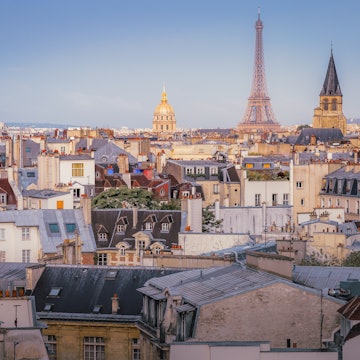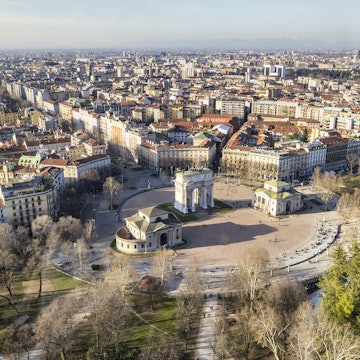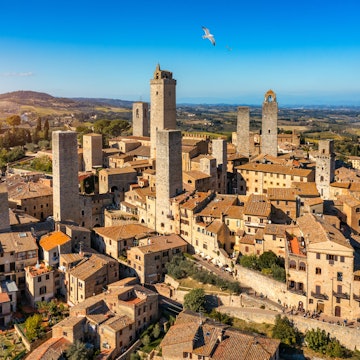

An old tram in Milan. Leonid Andronov/Getty Images
Ditch the car; you won’t need it in Milan. Largely flat, brilliantly compact, easy to navigate, increasingly green and surprisingly well organized, Italy’s second-biggest city is a breeze to get around, whether you plan to tick off the sights roaming the historic center or zip about town by metro, tram or bus. Even better: Milan is upping its green credentials with the aim of converting its entire public transport network to electric power by 2030.
From vintage trams to bike-sharing schemes that let you roll through the city at leisure, these are the very best ways to get around Milan.

Explore Milan on foot
Pack a pair of stylishly sensible shoes; Milan is among Europe’s most walkable cities. And if you’re sticking to the Centro Storico (historic center), where you can easily skip between trophy sights like the Gothic Duomo, the opulent La Scala opera house, the glass-vaulted Galleria Vittorio Emanuele II and the Old Master-crammed Gallerie d’Italia. You need never step so much as a foot on public transport, except when getting to and from the airport.
There’s a beauty to walking in Milan, too, as the city really reveals itself to those who take the time to pound its elegant backstreets, passing piazzas, gardens and flower-filled courtyards hidden behind wrought-iron gates.
Hop on Milan’s metro
Metro is often the fastest - if not the most scenic - way to get around Milan. ATM runs Milan's public-transport network, including the metro. There are five major lines: M1 (red) connects Duomo with Porta Venezia, the castle, Corso Magenta and the Fiera; M2 (green) connects Porta Garibaldi with Brera neighborhood and picturesque Navigli district; M3 (yellow) connects the Quadrilatero fashion area with the historic Porta Romana; M4 (blue), the newest line, speeds between Linate Airport and the city center in just 12 minutes; and M5 (lilac) connects San Siro with Porta Garibaldi and the trendy neighborhood of Isola. The metro operates between 5:30am and 12:30am (from 6am on Sunday).
A single-ride ticket costs 2.20 euros and is valid for 90 minutes. Planning on moving around a lot? A 24-hour ticket costs €7.60, a three-day ticket €15.50 and a carnet of 10 tickets €19.50. You can buy your tickets from the multilingual machines at metro stations or from a tabacchi shop. Download the free ATM app for network maps, digital tickets (you’ll need the QR code to enter and exit stations) and timetables. You can also buy tickets by sending an SMS to 48444 when you're in Italy.
If you prefer, use a contactless credit or debit card or digital wallet to pay as you go. Be sure to touch your card on the reader to open the gate at the start of your journey and touch out to exit at the end.

Pedal past big-hitter sights with BikeMi! bike-sharing
Getting around Milan is a joy if you rent your own wheels, with an ever-evolving network of bike lanes. BikeMi! is the city’s bike-sharing system, with 325 bike stations all over Milan; check out the map on the website for a full overview. Besides classic bikes, there are e-bikes and pedal-assisted bicycles with child seats.
Using the system is simple. Subscribe and register on the BikeMi! website or through the app, find your nearest bike station and unlock your bike. For BikeMi you can also register at the ATM Info Point at major metro stations including Duomo, Cadorna or Centrale. Choose from daily (€4.50), weekly (€9) and annual (€36) subscriptions. The maximum time limit for each trip is two hours. You’ll be given a user code and password when you register. The first 30 minutes of biking is free, with an additional €0.50 charged per half hour.
Whizz through Milan by tram or bus
ATM also runs Milan’s tram and bus network, which can be handy for sightseeing and reaching the south and northwest of the city. See the ATM app for timetables, route maps and tickets, which cost the same as those for the metro. Tickets need to be validated when boarding. Trams operate from roughly 5am to 2am; buses 5:30am to 12:30am, at which point night buses take over until 6am.
For a self-guided spin of the sights, hop aboard Tram 1, a vintage, bee-yellow affair, with wooden benches and original fittings, that rattles through the historic center. Trams 2 and 3 are particularly useful for sightseeing, while trams 9 and 10 loop around the center via Porta Venezia, Porta Genova and Porta Garibaldi.
Take the Passante
Modelled on Germany’s S-Bahn trains, Milan’s Passante railway trundles underground through the city and its suburbs. It’s a quick, efficient means of getting between major hubs like railway and metro stations. Tickets cost the same as those for the metro.

Frequently asked questions
What’s it like to drive in Milan?
There’s no need for a car if you’re staying central. Avoid the hassle of traffic-clogged narrow streets, car-free zones and nightmare parking by using the cheap and efficient public transport system instead. Of course, if you’re heading beyond Milan, you might want the freedom of renting a car. You’ll find reputable car hire companies at the airport and at the main train station, Milano Centrale, including Sixt and Hertz.
Is Uber available in Milan?
Yes, Uber is available in Milan and you can book a ride up to 90 days ahead. Sign in online or get the app. It’s useful for trips to and from the airport, for instance.
How easy is it to get a taxi?
Milan’s official taxis are white and run on a meter. Your best bet is to order one through an app like InTaxi or appTaxi or by calling 02 40 40, 02 69 69 or 02 85 85. If you’re lucky, you might be able to hail one off the street, but it’s often quicker and easier to head to designated ranks outside train stations, large hotels and in major piazzas.
Bear in mind that when you call for a cab, the meter runs from receipt of the call, not pickup. The average short ride costs between €10 and €12. You might struggle to get a taxi when big events like fashion week are on and demand goes through the roof.
Accessible transportation in Milan
Milan has made strides to become more accessible, but there is room for improvement. While the city is largely flat, cobbles and tram tracks can be tricky to negotiate with a wheelchair.
In terms of the metro, the newer Line 3 (M3), Line 4 (M4) and Line 5 (M5) are fully accessible with lifts, tactile floor markings and panels, and accessible toilets. With Line 1 (M1) and Line 2 (M2), accessibility varies from station to station, so journeys require more careful planning. Buses are a good bet as they offer low-level access and ramps for easy boarding. Trams are more of a mixed bag: some have ramps, floor markings, acoustic signals and dedicated wheelchairs spaces, others don’t.
If you require special assistance on the ground in Milan, visit the ATM website for the inside scoop on accessible transport in the city.
















